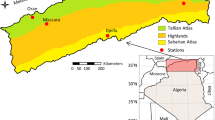Abstract
Equivalent temperature based in the NCEP/NCAR reanalysis database has been used as a simultaneous measure of temperature and humidity. Its variations during the 1958-1998 added to the effect of the inclusion of satellite data during the late seventies have been analyzed. An increase of the globally averaged equivalent temperature has been detected, the trend has been considerably greater during the first half of the study period and significant differences can be found between continental and oceanic areas. The relation of the trend with four of the main modes of climate variability has been assessed. The North Atlantic Oscillation and the Artic Oscillations are closely related to the equivalent temperature over the North Atlantic basin, extending toward Northern Asia in the second case. El Niño/Southern Oscillation and the Antarctic Oscillation seem to have a more global effect.
Similar content being viewed by others
References
Diaz H.F. and Markgraff V. (Eds), 2000. El Niño and the Southern Oscillation. Cambridge University Press. Cambridge, 496 pp.
Gaffen D.J. and Ross R.J., 1999. Climatology and trends of U.S. surface humidity and temperature. J. Climate, 12, 811–828.
Gong D. and Wang S., 1999. Definition of the Antarctic Oscillation index. Geophys. Res. Lett., 26, 459–462.
Hurrell J.W., 1995. Decadal trends in the North Atlantic Oscillation: regional temperatures and precipitation. Science, 269, 676–679.
Hurrell J.W., 1996. Influence of variations in extratropical wintertime teleconnections on Northern Hemisphere temperature. Geophys. Res. Lett., 23, 665–668.
Hurrell J.W. and Trenberth K.E., 1998. Difficulties in obtaining reliable temperature trends: reconciling the surface and satellite microwave sounding unit records. J. Climate, 11, 945–967.
Jones P.D., Jönsson T. and Wheeler D., 1997. Extension to the North Atlantic Oscillation using early instrumental pressure observations from Gibraltar and South-West Iceland. Int. J. Clim., 17, 1433–1450.
Kalnay E., Kanamitsu M., Kistler R., Collins W., Deaven D., Gandin L., Iredell M., Saha S., White G., Woollen J., Zhu Y., Chelliah M., Ebisuzaki W., Higgins W., Janowiak J., Mo K.C., Ropelewski C., Wang J., Lectmaa A., Reynolds R., Jenne R. and Joseph D., 1996. The NCEP/NCAR 40-year reanalysis project. Bull. Amer. Meteorol. Soc., 77, 437–471.
Kistler R., Kalnay E., Collins W., Saha S., White G., Woollen J., Chelliah M., Ebisuzaki W., Kanamitsu M., Kousky V., van den Dool H., Jenne R. and Fiorino M., 2001. The NCEP-NCAR 50-year reanalysis. Monthly means CD-ROM and documentation. Bull. Amer. Meteor. Soc., 82, 247–267.
Peixoto J.P. and Oort A.H., 1996. The climatology of relative humidity in the atmosphere. J. Climate, 9, 3443–3463.
Randel D.L., Von der Haar T.H., Ringerund M.A., Stephens G.L., Greenwald T.J. and Combs C.L., 1996. A new global water vapor dataset. Bull. Amer. Meteorol. Soc., 77, 1233–1246.
Ropelewski C.F. and Jones P.D., 1987. An extension of the Tahiti-Darwin Southern Oscillation Index. Monthly Weather Review, 115, 2161–2165.
Ross R.J. and Elliot W.P., 1996. Tropospheric precipitable water: A radiosonde-based climatology. NOAA Tech. Memo. ERL-ARL-219, Springfield, VA., 132 pp
Steadman R.G., 1984. A universal scale of apparent temperature. J. Clim. Appl. Meteorol., 23, 1674–1282.
Thompson D.W. and Wallace J.M., 2000. Annular modes in the extratropical circulation. Part I: Month-to-month variability. J. Climate, 13, 1000–1016.
Von Storch H. and Zwiers F.W., 1999. Statistical Analysis in Climate Research. Cambridge University Press, 484 pp.
Wallace J.M. 2000. North Atlantic Oscillation/Annular mode: Two paradigms-one phenomenon. Quart. J. Royal Meteorol. Soc., 126, 784–812.
Author information
Authors and Affiliations
Rights and permissions
About this article
Cite this article
Ribera, P., Gallego, D., Gimeno, L. et al. The Use of Equivalent Temperature to Analyse Climate Variability. Studia Geophysica et Geodaetica 48, 459–468 (2004). https://doi.org/10.1023/B:SGEG.0000020841.53546.39
Published:
Issue Date:
DOI: https://doi.org/10.1023/B:SGEG.0000020841.53546.39




